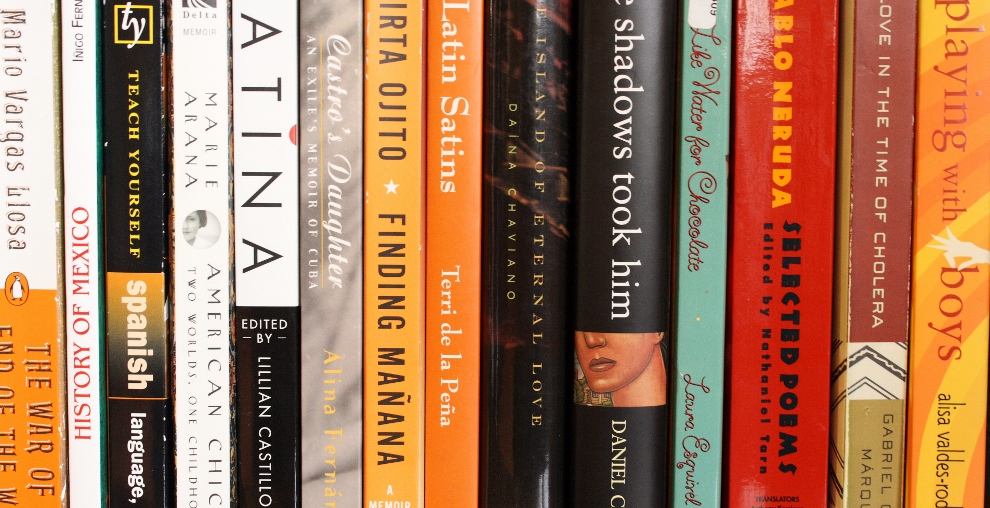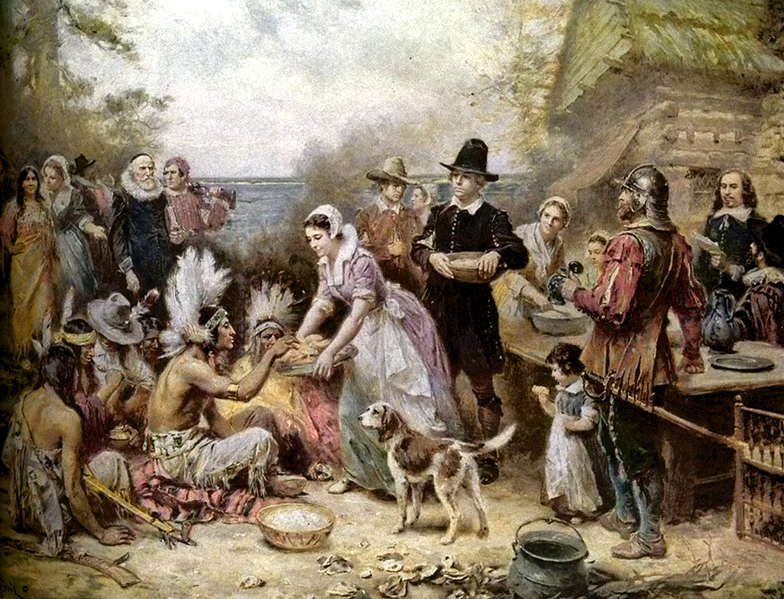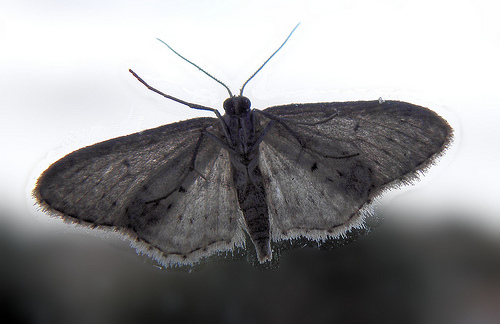Reading in Spanglish

25
Nov 2011
Weekend Roundup
posted in: UncategorizedSo, I know I haven’t been around for a while . . . but it’s because I have great news – I’m employed! With the job I got a lot of craziness going on, but I’m back to blogging!
I hope everyone had a great día de Acción de Gracias. It’s my second-favorite holiday!
I love this painting of the benevolent Pilgrims breaking bread with the Indians. I also found this old article in which a historian explains that the first Thanksgiving was actually held by a Spaniard. They ate frijoles, of course.
Ethnic Studies Myths :: via Tucson Weekly – I had hoped for a little more after seeing the title of this article. If you don’t know all the Arizona players, it’s a little confusing. But this article does go a lot deeper in the tit-for-tat politics surrounding the Arizona ban on Mexican-American ethnic studies than other sources. I love the tone.
Mexican Studies = Hitler Youth :: via Huffington Post – What we are learning this weekend is that Mexican-American studies programs inspire young students to overthrow the U.S. government, convert them to practice cult religions, and teach them that Latinos in the U.S. used to be oppressed. Because banning Mexican-American studies is not currently oppressing any one group.
Text of the Arizona Ethnic Studies Ban :: Sigh.
University of Northern Iowa Center for Multicultural Education Book Club :: via wcfcourier.com – Details on the book club, which will feature Latin@ literature.
Seeking Assistant/Associate Professor of English and Latin@ Literature and Culture :: via HigherEdJobs – This position is at the University of Arkansas. You know, I thought it was weird that Arizona – with a high Latino population – would be going this route. I expected it where I live in Alabama. At least the University of Arkansas seems to be admitting that Latin@s have contributed to the American experience.
1 comment12
Nov 2011
Weekend Roundup!
posted in: UncategorizedHave a great weekend!
Interactive book cover :: via GalleyCat – A new foray into the digital book world.
Whiting Foundation announces award winners :: via Whiting Foundation – includes Latino author Eduardo C. Corral (and possibly Daniel Orozco, whom I couldn’t confirm is Latino)
NYT announces 2011 Best Illustrated Children’s Books :: via New York Times – includes A Nation’s Hope: The Story of Boxing Legend Joe Louis by Matt de la Peña and another interesting book (not written by a Latino) about a group of historical migrants who traveled between Mexico and Canada, Migrant by Maxine Trottier
Pecados y Milagros :: via PRI The World – A radio interview with Lila Downs regarding her latest album, which deals with the drug violence in Mexico – a sort of answer to narcocorridos
Poet Tomas Segovia Dies :: via Fox News Latino
Pen Literary Award :: via Sign On San Diego – Pam Muñoz Ryan won this award for her book The Dreamer, a children’s book about Pablo Neruda
1 comment
10
Nov 2011
Latina Self-Portraits and Helena Maria Viramontes
posted in: Authors, books, Helena Maria ViramontesSometimes I sit down to write and think, What do I write about? What interesting thing has happened to me that qualifies me to write a piece that is lucid on the topic of human nature? What can I say, it’s a writer’s neurosis. When I read works by Latina authors, I find myself relating to them, nodding my head and thinking, “Exactly!” and, “How did they know that?” It is then that I realize that writing what you know is hard because it’s actually writing everything that you take for granted.
Latina Self-Portraits, edited by Bridget Kevane and Juanita Herdia, is a somewhat older book (published in 2000 by University of New Mexico Press) that contains the interviews of 10 Latina authors, including Cherríe Moraga, Sandra Cisneros, and Julia Alvarez. The introduction is a bit scholarly (I actually think I bought this for a college project on Chicano literature), but the interviews are frank and interesting, so it really doesn’t matter whether your aim is to “[define] the literary space of Latina literature” or if you’re just interested in hearing what the authors had to say. I was astounded that even though the interviews took place in the late 1990s, the author’s thoughts and commentary on Latino culture are still so relevant. I did have to chuckle when Julia Alvarez, asked about a younger generation of Latino writers, says, “Oh yeah! Junot Díaz!”
Anyway, I was looking back over this book which I read a few years ago and wanted to focus on an author whose work I haven’t read. I picked Helena Maria Viramontes. Viramontes is the author of The Moths and Other Stories, Under the Feet of Jesus, and Their Dogs Came with Them.
The interview touches on several topics from farmworkers to her personal life to the influence of corridos. I LOVE that Viramontes says that the answer to whether to italicize phrases in Spanish is “absolutely not.” I feel the same way, at least for Latino literature. To me, Spanish is not a foreign language in our culture, so I don’t think the style rule applies.
Viramontes also talked about the writing process. Of the solitude of writers, she said, “We arrive in our seats with our sense of insecurities as human beings incapable of capturing the visions in our heads. With our open bleeding hearts, we arrive to make some understanding for ourselves and for the readers.”
One of Viramontes’s well-known short stories is “The Moths,” about a girl and her dying grandmother. The haunting story was inspired by an equally haunting photograph of a Japanese woman bathing her deformed child.
Viramontes writes a story of a girl caught between two cultures. The details are true. I can’t think of a better word, they’re just TRUE. The main character at one point remembers, “As I opened the door and stuck my head in, I would catch the gagging scent of toasting chile on the placa. . . . The chiles made my eyes water.”
Just yesterday I opened the window while toasting chiles on the placa, and wondered to myself why I don’t just roast them in the oven like I see gringos doing on television. Maybe it wouldn’t burn so much. But no, that wouldn’t be like my abuela did. And that simple part of making dinner made me remember my abuela and her housekeeping, her embroidery and tejidos, and sus hierbas for curing all ills. Today I read about my grandma in Viramontes’s story.
I won’t reveal more details because it would spoil such a short story. You have to read it yourself. But I think that this is the greatest compliment I can give an author – that when I read this story, I saw myself.
no comments
























